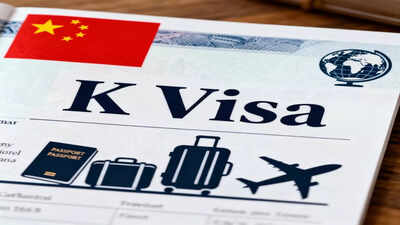
China’s newly introduced K visa category, which is effective from October 1, 2025, is widely being seen as a counter (though not official!) to the Donald Trump administration’s crackdown on the H-1B visa programme. At a time when the US is imposing stricter immigration policies, China is clearly signalling an intent to ‘welcome’ global talent.The newly introduced K visa, announced in August, aims to attract young international STEM (Science, Technology, Engineering and Mathematics) graduates by offering entry, residency and work authorization without requiring any prior work offer.
Although China has abundant local engineering expertise, the K visa initiative forms part of Beijing’s strategy to present itself as welcoming to international investment and skilled professionals, especially as US trade restrictions create uncertainty in China’s economic landscape.The Trump administration recently hiked the H-1B visa application fee to $100,000, a move that sent shockwaves globally, and especially in the Indian IT sector which is a big beneficiary of this particular visa programme. The US is also looking to do away with the current H-1B visa lottery system, replacing it with a weighted system for visa allotment.In this backdrop, China’s K visa could potentially strengthen its position against the US in their geopolitical competition. What is China’s K visa, what are its application criteria, benefits, and challenges? We take a look:
What is China’s K Visa?
According to a KPMG analysis, China established the R visa for highly skilled professionals in 2013, but the introduction of the K visa specifically aims to attract foreign youth talent in science and technology fields. K visa holders will benefit from increased flexibility in managing their activities within China, facilitating broader scientific and technological cultural exchange programmes, says KPMG.So who qualifies for China’s K visa?
- International graduates holding bachelor’s or higher degrees in STEM disciplines from prestigious universities or research centres globally or within the country (additional information about qualifying institutions forthcoming);
- Young foreign professionals currently working in education and research roles within STEM-related domains.
And what are the benefits of K visa?
- Length of residency: Offers enhanced flexibility regarding entry frequency and validity duration compared to standard visa categories currently available.
- Permitted activities: Includes participation in educational, scientific, technological, cultural, entrepreneurial and commercial collaborative endeavours.
- Entry criteria: Eliminates requirement for local company sponsorship, focusing instead on applicant’s age, academic qualifications, or professional experience as determining factors.
Is China’s K visa the counter to Trump’s H-1B visa crackdown?
China’s K visa could present an attractive option for overseas professionals seeking alternatives to US employment opportunities. Several countries, including South Korea, Germany and New Zealand, are implementing more accessible visa regulations to draw skilled migrants. Beijing has implemented various policies to encourage foreign investment and travel, including expanding access for international investors across multiple sectors and removing visa requirements for nationals from most European nations, Japan, South Korea and others.“The symbolism is powerful: while the US raises barriers, China is lowering them,” notes Iowa-based immigration attorney Matt Mauntel-Medici according to a Reuters report.The Trump administration’s recent announcement of a $100,000 annual fee requirement for H-1B worker visas, commonly utilised by technology firms for skilled foreign recruitment, has created new opportunities. “The US has definitely shot itself in the foot on H-1Bs, and the timing is exquisite for China’s K visa,” noted Michael Feller, chief strategist at Geopolitical Strategy.Immigration specialists highlight that the K visa’s primary advantage lies in eliminating the need for employer sponsorship, traditionally a significant obstacle for H-1B applicants. The H-1B programme’s current structure requires company sponsorship and operates through a lottery system limited to 85,000 positions annually, with the newly proposed fee potentially discouraging first-time applicants.“It’s an appealing alternative for Indian STEM professionals seeking flexible, streamlined visa options,” Bikash Kali Das, an Indian student at Sichuan University told Reuters. Indians represented the largest group of H-1B recipients last year, comprising 71% of successful applicants.
China K visa : The challenges
- China’s K visa programme implementation faces several obstacles. The Chinese authorities have specified unclear requirements relating to “age, educational background and work experience”.
- The policy lacks transparency regarding monetary benefits, job placement support, long-term residency options and provisions for bringing family members.
- China rarely grants citizenship to foreign nationals, unlike US immigration policies.
- The predominant use of Mandarin in Chinese technology companies creates significant obstacles for professionals who don’t speak the language.
The diplomatic friction between India and China might restrict the intake of Indian professionals under the K visa programme, experts told Reuters.“China will need to ensure Indian citizens feel welcome and can do meaningful work without Mandarin,” said Feller.China has historically concentrated its talent acquisition efforts on scientists of Chinese origin residing overseas and individuals of Chinese descent abroad.Substantial incentives, including housing allowances and welcome bonuses reaching 5 million yuan ($702,200), have successfully attracted Chinese STEM professionals from the United States, particularly as Washington intensifies its scrutiny of China-linked activities.“The recruitment effort targeting Indian tech talent in China is growing but remains moderate compared to the more intensive, well-established, and well-funded initiatives aimed at repatriating Chinese STEM talent,” said Sichuan University’s Das.A Chinese STEM graduate, who recently received employment offers from Silicon Valley, expressed doubts about the K visa programme’s effectiveness.“Asian countries like China don’t rely on immigration and local Chinese governments have many ways to attract domestic talent,” he told Reuters.The United States hosts 51 million immigrants, comprising 15% of its population, whilst China accommodates merely 1 million foreigners, representing less than 1% of its residents.Whilst China is not expected to implement substantial changes to its immigration policies to accommodate millions of foreign workers, experts suggest the K visa could enhance Beijing’s position in its technological competition with the US.“If China can attract even a sliver of global tech talent, it will be more competitive in cutting-edge technology,” Feller said.








